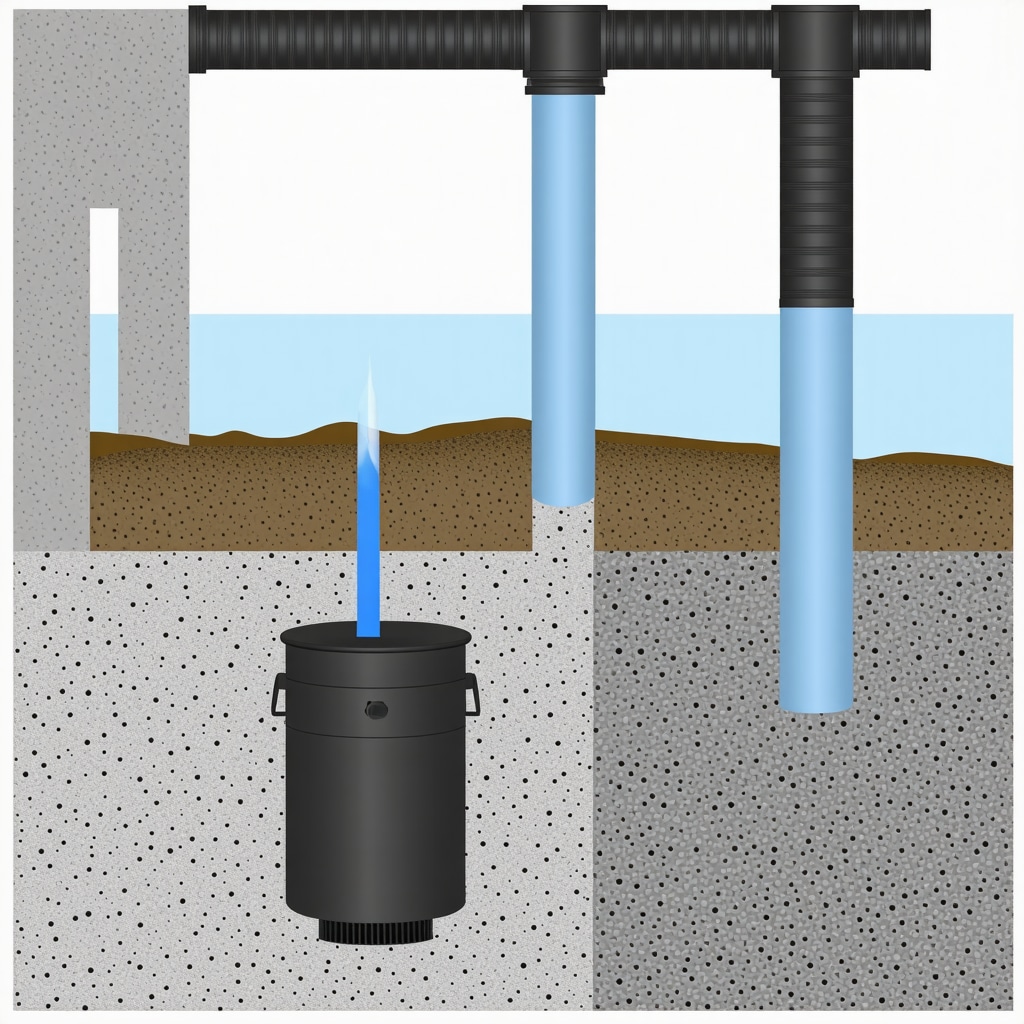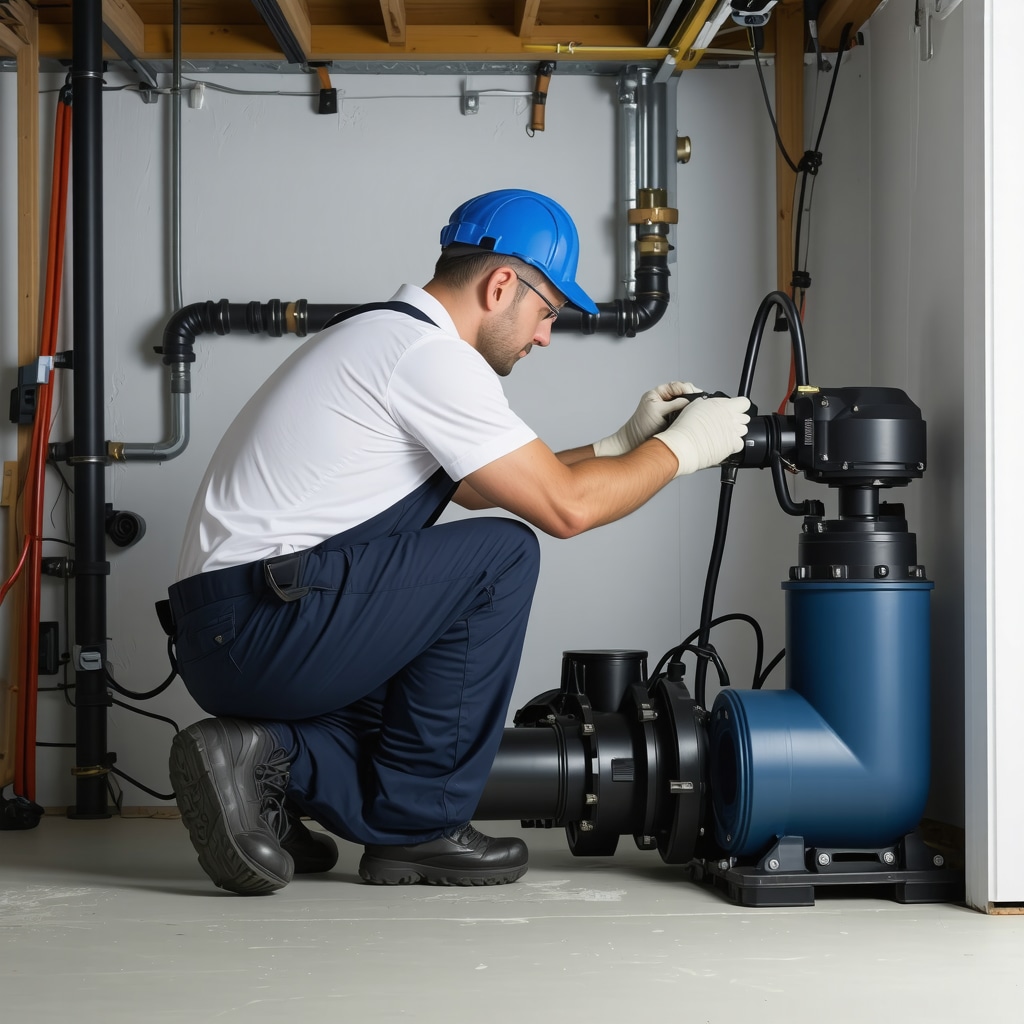Ever Wondered How to Keep Your Basement Dry as a Bone?
Picture this: it’s pouring outside, thunder rumbling like a rock concert, and you’re cozy inside, blissfully unaware that your basement is plotting a flood. Enter the hero of our story: the humble sump pump. Installing a sump pump system isn’t just about preventing water chaos; it’s about turning your home into a fortress of waterproof serenity.
Why Every Homeowner Should Consider a Sump Pump System
Water intrusion is the silent villain lurking beneath the surface. According to the United States Geological Survey, heavy rainfall can cause basement flooding, leading to costly repairs and mold nightmares. A well-installed sump pump acts as your home’s immune system, swiftly removing excess water and keeping your living space safe.
Picking the Right Sump Pump: More Than Just a Fancy Name
Choosing the perfect sump pump isn’t about the most expensive model but about matching capacity with your home’s unique needs. Think of it as dating—compatibility matters! Factors like the pump’s horsepower, switch type, and durability are crucial. For instance, a submersible pump offers quiet operation and space-saving benefits, making it a popular choice among DIY enthusiasts.
Step-by-Step Guide: Installing Your Sump Pump Like a Pro
Ready to roll up your sleeves? First, select a location in your basement’s lowest point—think of it as planting the home’s water watchdog. Dig a pit, ensuring it’s deep enough to accommodate the sump basin. Connect the pump to a discharge pipe that directs water safely away from your foundation—preferably uphill, because gravity is your friend here. Don’t forget a battery backup system for those stormy nights when power takes a vacation. For detailed instructions, check out this comprehensive DIY guide.
Is Your Home Ready for a Waterproof Makeover?
Beyond the sump pump, consider sealing cracks, installing window wells, and grading your yard to divert water away from your basement. Think of it as giving your home a comprehensive waterproofing facelift. Remember, a sump pump system is the backbone, but a holistic approach ensures long-term dryness.
If you’re pondering whether to tackle this project yourself or call in the pros, weigh the benefits of DIY satisfaction against the safety net of professional installation. Either way, your basement will thank you!
Feeling inspired? Drop your thoughts, questions, or success stories in the comments below. For more innovative home solutions, explore smart DIY ideas and turn your house into a DIY paradise!
Ever Wondered How to Keep Your Basement Dry as a Bone?
Imagine a heavy storm pounding outside while your home remains a dry sanctuary inside. That’s the power of a well-installed sump pump system. It’s not just a device; it’s your home’s frontline defense against water intrusion, transforming your basement from a vulnerable space into a fortress of dryness.
Why a Sump Pump System is Your Home’s Best Friend
Water intrusion is often a silent threat, creeping in unnoticed until it causes significant damage. According to the United States Geological Survey, heavy rainfall and rising groundwater levels can lead to basement flooding, mold, and structural issues. Installing a sump pump system provides peace of mind by actively removing excess water, preventing these costly problems before they start.
Choosing the Right Sump Pump: Compatibility Over Cost
Not all sump pumps are created equal. The key is matching the pump’s capacity with your home’s specific needs. Think of it as finding a perfect match in a dance—compatibility is everything! Factors such as horsepower, switch type, and durability should guide your choice. A submersible pump, for example, offers quiet operation and space efficiency, making it a popular DIY-friendly option for many homeowners.
Step-by-Step DIY Guide: Installing Your Sump Pump with Confidence
Are you ready to take on this essential project? First, identify the lowest point in your basement—this is where your sump basin will sit, acting as the home’s own water watchdog. Dig a hole deep enough to accommodate the basin, ensuring a snug fit. Next, place the basin securely, connect the pump to a discharge pipe that directs water away from your foundation—uphill, because gravity works best when you give it a helping hand. Don’t forget to incorporate a battery backup system for those stormy nights when power might be out. For detailed instructions, explore this comprehensive DIY guide.
Is Your Home Truly Prepared for a Waterproof Makeover?
Beyond the sump pump, consider sealing cracks, installing window wells, and grading your yard to divert water away from the foundation. Think of it as giving your home a complete waterproofing makeover. While the sump pump is the backbone of this system, a holistic approach ensures long-term dryness and peace of mind.
If you’re contemplating whether to DIY or hire a professional, weigh the satisfaction of a job well done against safety considerations. Either way, your basement will thank you for the proactive upgrade!
Feeling inspired? Share your thoughts, questions, or success stories in the comments below! For more innovative DIY solutions that protect and enhance your home, visit smart DIY ideas and turn your house into a DIY paradise!
Unraveling the Mysteries of Basement Waterproofing: Beyond the Basics
When it comes to safeguarding your home’s foundation, understanding the intricacies of waterproofing can mean the difference between peace of mind and costly repairs. While sump pumps are essential, they are just one piece of a complex puzzle that includes drainage systems, sealants, and structural modifications. As an expert in building science, I’ll guide you through advanced techniques that ensure your basement remains dry, even in the most challenging conditions.
The Science Behind Effective Waterproofing: A Holistic Approach
Effective waterproofing hinges on controlling water movement at multiple levels. According to the Building Science Corporation, implementing a layered defense system—combining surface sealing, drainage, and structural reinforcement—prevents water ingress more reliably than relying solely on sump pumps. This approach mirrors how the human immune system works, providing multiple barriers against potential threats.
How Do Continuous Drainage Systems Enhance Basement Dryness?
Subsurface drainage plays a pivotal role in managing groundwater. French drains and interior weeping tiles divert water away from the foundation, reducing hydrostatic pressure. Modern solutions like perforated pipe systems wrapped in filter fabric optimize water flow while preventing clogging. A well-designed drainage system works synergistically with sump pumps, ensuring that excess water is swiftly directed away from your home.

Innovative Sealant Technologies for Long-Term Durability
Sealants are the unsung heroes of basement waterproofing. Advanced polymer-based elastomeric coatings and crystalline waterproofing admixtures penetrate concrete pores, creating a chemical barrier that withstands the test of time. According to a 2022 study published in the Journal of Building Engineering, these materials significantly reduce permeability and resist cracking, which are common entry points for water.
What Are the Best Practices for Seamless Structural Integration?
Sealing cracks, joints, and penetrations requires meticulous attention. Using flexible sealants that accommodate structural movement prevents gaps from forming. Installing backer rods before applying sealants ensures proper adhesion and longevity. For critical areas like wall-floor joints, applying hydrophobic coatings combined with mechanical barriers offers a proactive defense against water infiltration.
Interested in elevating your waterproofing game? Consulting with a building envelope specialist can provide tailored solutions that integrate these advanced methods seamlessly into your home’s design.
Embarking on a Custom Waterproofing Strategy: The Expert’s Checklist
- Assess hydrostatic pressure levels using geotechnical data—this informs drainage and sealing requirements.
- Design a layered system that combines surface waterproofing, internal drainage, and sump pump backup.
- Select high-performance materials proven in laboratory and field tests.
- Implement structural modifications—such as wall reinforcement and foundation grading—to complement waterproofing measures.
- Regularly inspect and maintain all components to adapt to changing environmental conditions.
By adopting a comprehensive, science-backed approach, you transform your basement from a vulnerable space into a resilient, dry sanctuary. Remember, waterproofing isn’t a one-time fix but an ongoing commitment to your home’s integrity.
Ready to elevate your waterproofing strategy? Connect with a professional engineer or waterproofing specialist who can customize these advanced techniques to your specific needs. Dive deeper into the science of building resilience and safeguard your investment for decades to come.
How Can Vapor Barriers and Airflow Optimization Elevate Your Basement Waterproofing?
While traditional waterproofing methods prioritize sealing and drainage, the integration of vapor barriers and strategic airflow management can significantly enhance your basement’s resilience against moisture buildup. According to the Building Science Corporation, deploying high-quality vapor barriers on interior walls and floors prevents the ingress of water vapor, which is often the precursor to mold and structural damage. Coupling this with deliberate airflow pathways—such as installing vented soffits or exhaust fans—helps dehumidify the air, maintaining optimal humidity levels and discouraging condensation.
What Are the Latest Innovations in Foundation Coatings for Long-Term Durability?
Emerging polymer-based coatings, like crystalline waterproofing admixtures, offer self-healing properties that actively respond to microcracks, effectively sealing them from water penetration. These materials, supported by studies in the Journal of Building Engineering, form a durable, seamless barrier that withstands hydrostatic pressure and chemical exposure. Applying such coatings before interior finishing provides an additional layer of defense, especially in historic or high-risk structures where foundation integrity is paramount.
Can Climate-Responsive Waterproofing Systems Adapt to Changing Environments?
Yes, climate-responsive systems utilize smart sensors and adaptive materials that respond dynamically to environmental fluctuations. For instance, integrating moisture sensors with automated dehumidifiers or venting systems can proactively regulate indoor humidity levels, preventing excess moisture from accumulating. This approach aligns with recommendations from the EPA’s ENERGY STAR program, emphasizing energy-efficient and sustainable solutions that adapt to climate variability, reducing long-term maintenance costs and ensuring ongoing basement dryness.
Implementing these expert-level strategies requires careful planning and, often, collaboration with building science professionals. If you’re interested in pioneering advanced waterproofing solutions tailored to your home’s unique conditions, consulting specialists can optimize outcomes and extend the lifespan of your investment. Have you experimented with innovative waterproofing methods? Share your experiences or questions in the comments below, and explore more about cutting-edge DIY home improvement techniques at Smart DIY solutions.
Expert Insights & Advanced Considerations
1. Integrate Multi-Layered Defense Systems
Combining surface sealants, internal drainage, and sump pump backups creates a resilient barrier against water ingress, reducing reliance on any single system and increasing overall protection.
2. Leverage Innovative Sealant Technologies
Using crystalline waterproofing admixtures and elastomeric coatings can provide self-healing capabilities and long-lasting seals, especially critical for historic or high-risk structures.
3. Optimize Foundation and Yard Grading
Proper grading directs surface water away from the foundation, reducing hydrostatic pressure and complementing waterproofing measures for comprehensive protection.
4. Incorporate Climate-Responsive Systems
Smart sensors, automated dehumidifiers, and adaptive materials respond dynamically to environmental changes, maintaining optimal moisture levels and preventing mold growth over time.
5. Prioritize Regular Inspection and Maintenance
Scheduled evaluations of drainage systems, sealants, and structural components ensure early detection of issues and prolong the effectiveness of waterproofing strategies.
Curated Expert Resources
- Building Science Corporation: Offers in-depth research and practical guidelines on holistic waterproofing approaches and advanced building envelope techniques.
- Journal of Building Engineering: Publishes peer-reviewed studies on innovative materials such as crystalline admixtures and elastomeric coatings, providing scientific backing for their use.
- EPA’s ENERGY STAR Program: Provides guidance on climate-responsive, energy-efficient moisture management solutions suitable for modern homes.
- Professional Waterproofing Consultants: Expert firms specializing in customized, science-backed waterproofing plans tailored to specific environmental conditions and structural needs.
Final Expert Perspective
Mastering basement waterproofing requires a sophisticated blend of science, technology, and craftsmanship. Integrating advanced sealants, multi-layered drainage, and climate-responsive systems ensures your home remains a dry sanctuary, regardless of weather challenges. Remember, ongoing maintenance and expert consultation are your best allies in preserving long-term dryness. For those eager to elevate their waterproofing game, exploring these resources and consulting specialists will unlock innovative solutions tailored to your unique needs. Dive deeper into the science of building resilience and turn your basement into a fortress of dryness by visiting Smart DIY ideas.

